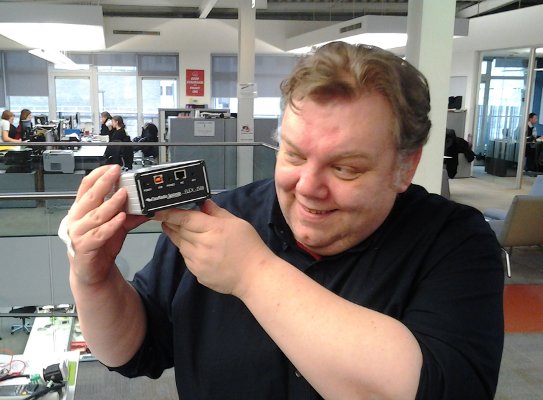Software defined radio makes for a happy hack

"So, Rupert," said the company. "Twenty years on the job. Ask for anything and it shall be yours."
I thought for a moment. "A pony, a robotic kitten made out of gold and water-lilies, and a Flex-1500 Software Defined Radio, please."
There's apparently some health-and-safety issue with the pony, and the robo-kitten's still in beta after it burned a small village to the ground with tail-mounted lasers, but rather delightfully the Flex-1500 SDR has turned up. Here it is, already making me happy:

And what is in the tiny silver box? It's a shortwave and VHF radio, but one where most of the hard work of detecting and creating signals is done by digital signal processing. The actual radio bits are simple - and all the complicated stuff is done in maths in software.
This all works very well; the radio is supposedly the equal of others costing factors of ten more. In radio, as in computing, there is equivalence between software and hardware: all functions can be described mathematically and it doesn't matter if the function itself is carried out by a network of hardware components or by crunching the numbers. With modern processors, indeed, the number crunching often works better: there are always compromises in electronic components. They always introduce noise, are never precise values, drift as they get old or hot, and have other physical imperfections. Expensive radios have expensive components where such things are minimised: do it digitally, however, and you can have the virtual equivalent of the most expensive, perfect components you can think of.
There are other advantages. You can create new transmission modes and new features just by writing software. You can have as many clever tuning modes and signal capture strategies as you can imagine, and never need to warm up a soldering iron. You can skip around the frequencies at will (something that gives regulators sleepless nights).
But mostly, you can rampage through the shoftwave bands like, as the young people say these days, a boss. You don't just tune in one signal: you tune in an entire chunk of the band simultaneously and pick out signals by eye. For the devoted radio fan, this is a new world of considerable delights and a splendid plaything. The next steps will be to hook up a rubidium atomic frequency standard to play with some of the more esoteric low-signal modes that rely on very precise timing, and to add a DJ console (yes, really) as a control surface. For while you can replace almost anything in a radio with software, there's no substitute for big knobs.